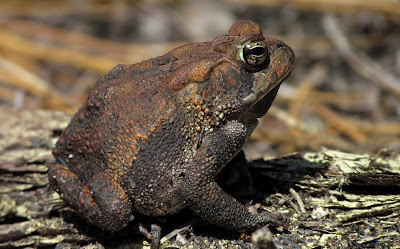For most birders, it’s their favorite time of year. During spring migration, male warblers are singing from the trees in their most audacious plumages, and other hard-to-find species make their annual acquaintance with North Carolina . For me, on the other hand, it’s all about gray mornings trying to locate the source of a song through trees newly thick with foliage. What a love-hate relationship.
I’ve seen plenty of great migrants, but I feel like I should be seeing more. American Redstarts have started singing, and I’ve had awesome looks at things like Scarlet Tanager. But none of these have graced my camera lens. And so, I turn again to the herps. Flipping a log next to a rushing stream, I found something that looked like a skink at first glance. Then I noticed that, while it retracted, it didn’t turn and run.
 |
| Oh, and he didn't try and bite me either. +1 for salamanders! |
Not a skink at all, but a gorgeous Three-lined Salamander! I had trouble trying to photograph this guy – every time I placed him on a nearby log, he’d tumble off before I had a chance to reach my chosen photo site. Eventually I got something usable, but he’s got forest crud on his face. Ah well, such is life. The trek next to the creek was strenuous (I had to climb over several rock faces), but it became worth it when I found this large Black Rat Snake. He was about 4 feet long, and raised up with his mouth open when I caught him, but it was just a show – he soon calmed down and wrapped himself around my outstretched arm. Largest snake I ever caught!
 |
| Getting all contrict-y on my arm... lucky thing I'm too big to be prey! |
A couple days later I traveled to Mason Farm with Mark and Ken to see what migrants we could turn up. Far from the promised birds, the best we could find were a couple Northern Waterthrushes and a singing Hooded Warbler. Oh well, at least the Indigo Buntings and Yellow-breasted Chats are back on territory. Just none of them would come close enough for a good picture!
 |
| Doesn't matter. Indigo Buntings are back! It's going to be a thing. |
Along the canal, Ken noticed a snake basking on a sunny mud bank. But it wasn’t just any snake – it turned out to be an awesome looking Redbelly Water Snake, and only the second I’ve ever seen that didn’t immediately slither into the water. After getting some sweet shots, Ken decided to do his best Jeff Corwin impression and try to catch the thing by flanking it. Unfortunately it spotted him and slithered off, and it’s too bad Ali Iyoob wasn’t there. He really wants to catch one, and I’ve no doubt he would have dived into the canal and nabbed it!
 |
| Mason Farm is pretty much the western terminus of their range in the Piedmont. Lucky us! |
Further down the canal, we found a couple turtles chilling on the nearly-submerged logs. One of the turtles didn't dive down as soon as he saw us, and it's a good thing too. He was a sweet-looking Painted Turtle, and it's easy to see why in the late afternoon light. The intricate yellows and reds that encircle this turtle positively glowed in the low sun, looking more like a work of art than an animal. Turtles don't get much better than this!
 |
| "I have no opinion on turtles. They're condescending." - Leslie Knope, Parks and Recreation |
While flipping logs, we found this nice male Five-lined Skink, perhaps the largest I’ve ever seen at 7 or 8 inches long. He was pretty bold and I managed to catch him as he sat out in the open. As they like to do, the skink immediately turned around and bit down hard on my thumb with a force much more painful than a snake bite. He actually managed to escape and climb down my back, and only regained his freedom when he bit Mark, who flipped out and flung him into the woods. Last I saw, the smug bastard was chilling back on his log, probably laughing at us humans.
 |
| Haha, you humans think you can pick me up? I will simply bite you into submission! |
The next couple days were good for migrants, but unfortunately cloudy. I got great looks at Summer Tanagers and Yellow-throated Vireos, but photography useless in the poor light. Luckily, Sunday proved to be a beautiful day, and I had several first-of-year birds, including a calling Yellow-billed Cuckoo. The cuckoo was very secretive, so I had to make do with a displaying male Red-winged Blackbird that flashed his distinctive epaulettes at anyone who’d pay attention.
 |
| He's sexy and he knows it. |
Pretty soon, James will be coming back from school and we’ll be tearing up the migrants big time. Can’t wait – summer’s almost here!














































